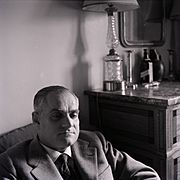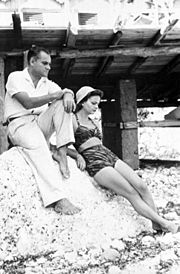Alberto Moravia facts for kids
Quick facts for kids
Alberto Moravia
|
|
|---|---|

Alberto Moravia photographed by Paolo Monti (Fondo Paolo Monti, BEIC)
|
|
| Born | Alberto Pincherle November 28, 1907 Rome, Italy |
| Died | September 26, 1990 (aged 82) Rome, Italy |
| Resting place | Campo Verano, Rome |
| Pen name | Alberto Moravia |
| Occupation | Novelist, journalist, playwright, essayist, film critic |
| Nationality | Italian |
| Notable works | Gli indifferenti (Time of Indifference, 1929) Il conformista (The Conformist, 1947) Racconti romani (Roman Tales, 1954) La ciociara (Two Women, 1957) |
| Notable awards | Strega Prize (1952) Premio Marzotto (1957) Viareggio Prize (1961) Premio Mondello (1982) |
| Spouse | |
| Partner | Dacia Maraini (1962–1978) |
|
|
|
Alberto Moravia (born Alberto Pincherle on November 28, 1907 – died September 26, 1990) was a famous Italian writer and journalist. He wrote many novels, short stories, and plays. His stories often explored how people felt and behaved in difficult times. Many of his books were turned into movies.
Contents
About Alberto Moravia
His Early Life
Alberto Pincherle was born in Rome, Italy, into a well-off family. His father, Carlo, was an architect and artist. His mother, Teresa, came from a region called Dalmatia.
Alberto did not finish regular school. When he was nine, he got a serious bone illness called tuberculosis. This kept him in bed for five years. He spent three years at home and two years in a special hospital near Cortina d'Ampezzo. Alberto was a very smart boy. He spent his time reading many books. Some of his favorite authors were Fyodor Dostoevsky, James Joyce, and William Shakespeare. He also learned French and German and wrote poems in both languages.
In 1925, at age 18, he left the hospital. Over the next three years, he started writing his first novel. It was called Gli indifferenti, which means Time of Indifference. He paid to have it published in 1929. Critics thought his first novel was very important for Italian writing at the time.
In 1927, Moravia began working as a journalist. He wrote for a magazine called 900. This magazine published his first short stories.
Facing Censorship
The years before World War II were hard for Moravia as a writer. The Fascist government in Italy controlled what people could say or write. They stopped reviews of his book Le ambizioni sbagliate (1935). They also took away his novel La mascherata (1941) and banned Agostino (1941).
To avoid this censorship, Moravia wrote stories that used symbols or dream-like ideas. In 1935, he traveled to the United States to give talks about Italian literature. In 1941, he married the novelist Elsa Morante. They lived on an island called Capri. There, he wrote Agostino.
When Italy stopped fighting in World War II in 1943, Moravia and Morante had to hide. They went to a town called Fondi. This experience later inspired his famous novel La ciociara (The ciociara Woman, 1957).
Becoming Popular
In May 1944, after Rome was freed, Alberto Moravia returned home. He started writing for important newspapers like Il Mondo and Il Corriere della Sera. He wrote for Il Corriere della Sera until he died. After the war, his popularity grew a lot.
In 1952, he won the Strega Prize for his short stories. His novels also began to be translated into other languages. In 1953, Moravia started a literary magazine called Nuovi Argomenti (New Arguments). Later, he also wrote movie reviews for magazines like L'Europeo and L'Espresso.
Later Years
In 1962, Moravia and Elsa Morante separated. He then lived with another writer, Dacia Maraini. He focused more on writing for the theater. In 1966, he, Maraini, and Enzo Siciliano started a theater group called Il Porcospino. They put on plays by Moravia and other writers.
In 1982, Moravia visited Japan, including Hiroshima. This trip made him write articles for L'Espresso magazine about the atomic bomb. He also wrote a novel called L'Uomo che Guarda (The Man Who Looks, 1985) and an essay about nuclear weapons.
His short story collection, La Cosa e altri racconti (The Thing and Other Stories), was dedicated to Carmen Llera. She was his new partner, and they married in 1986. In 1984, Moravia was elected to the European Parliament. He became a member of the European Parliament, representing Italy. He was often considered for the Nobel Prize in Literature.
From 1959 to 1962, Moravia was the president of PEN International. This is a worldwide group for writers.
His Famous Works
Moravia is best known for his first novel, Gli indifferenti (1929). He is also famous for his anti-Fascist novel Il Conformista (The Conformist). This book was made into a movie called The Conformist in 1970.
Many of his other novels were also made into movies:
- Agostino was filmed with the same title in 1962.
- Il disprezzo (A Ghost at Noon or Contempt) became the movie Contempt in 1963.
- La Noia (Boredom) was filmed as The Empty Canvas in 1963.
- La ciociara was made into the movie Two Women in 1960.
His Death
Alberto Moravia died in 1990 in Rome. That same year, his autobiography, Vita di Moravia (Life of Moravia), was published.
See also
 In Spanish: Alberto Moravia para niños
In Spanish: Alberto Moravia para niños


